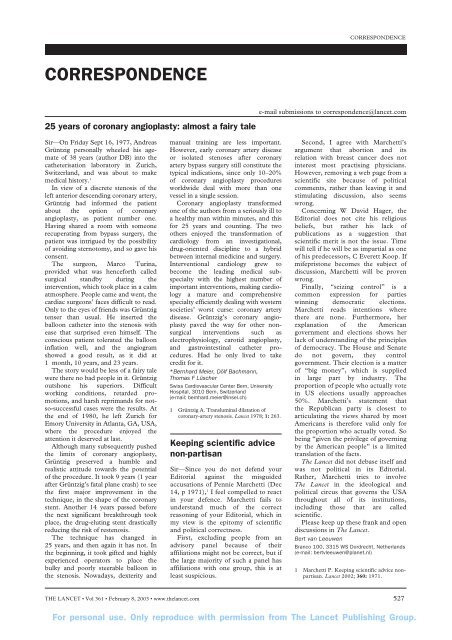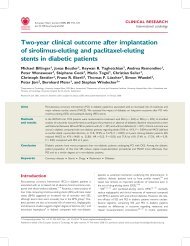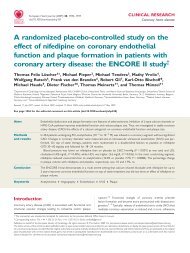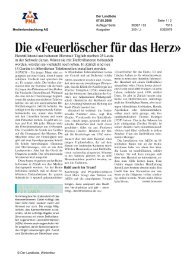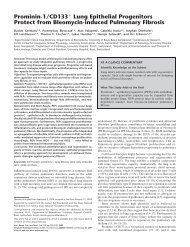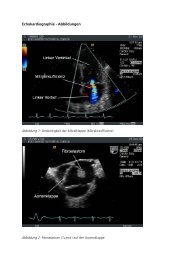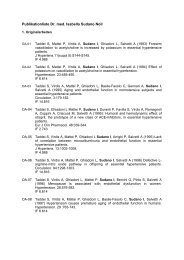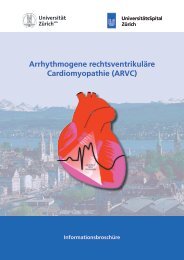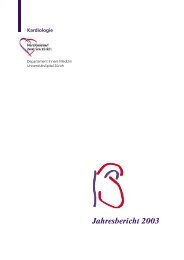CORRESPONDENCE - Klinik für Kardiologie
CORRESPONDENCE - Klinik für Kardiologie
CORRESPONDENCE - Klinik für Kardiologie
Create successful ePaper yourself
Turn your PDF publications into a flip-book with our unique Google optimized e-Paper software.
COMMENTARY<br />
<strong>CORRESPONDENCE</strong><br />
<strong>CORRESPONDENCE</strong><br />
25 years of coronary angioplasty: almost a fairy tale<br />
e-mail submissions to correspondence@lancet.com<br />
Sir—On Friday Sept 16, 1977, Andreas<br />
Grüntzig personally wheeled his agemate<br />
of 38 years (author DB) into the<br />
catheterisation laboratory in Zurich,<br />
Switzerland, and was about to make<br />
medical history. 1<br />
In view of a discrete stenosis of the<br />
left anterior descending coronary artery,<br />
Grüntzig had informed the patient<br />
about the option of coronary<br />
angioplasty, as patient number one.<br />
Having shared a room with someone<br />
recuperating from bypass surgery, the<br />
patient was intrigued by the possibility<br />
of avoiding sternotomy, and so gave his<br />
consent.<br />
The surgeon, Marco Turina,<br />
provided what was henceforth called<br />
surgical standby during the<br />
intervention, which took place in a calm<br />
atmosphere. People came and went, the<br />
cardiac surgeons’ faces difficult to read.<br />
Only to the eyes of friends was Grüntzig<br />
tenser than usual. He inserted the<br />
balloon catheter into the stenosis with<br />
ease that surprised even himself. The<br />
conscious patient tolerated the balloon<br />
inflation well, and the angiogram<br />
showed a good result, as it did at<br />
1 month, 10 years, and 23 years.<br />
The story would be less of a fairy tale<br />
were there no bad people in it. Grüntzig<br />
outshone his superiors. Difficult<br />
working conditions, retarded promotions,<br />
and harsh reprimands for notso-successful<br />
cases were the results. At<br />
the end of 1980, he left Zurich for<br />
Emory University in Atlanta, GA, USA,<br />
where the procedure enjoyed the<br />
attention it deserved at last.<br />
Although many subsequently pushed<br />
the limits of coronary angioplasty,<br />
Grüntzig preserved a humble and<br />
realistic attitude towards the potential<br />
of the procedure. It took 9 years (1 year<br />
after Grüntzig’s fatal plane crash) to see<br />
the first major improvement in the<br />
technique, in the shape of the coronary<br />
stent. Another 14 years passed before<br />
the next significant breakthrough took<br />
place, the drug-eluting stent drastically<br />
reducing the risk of restenosis.<br />
The technique has changed in<br />
25 years, and then again it has not. In<br />
the beginning, it took gifted and highly<br />
experienced operators to place the<br />
bulky and poorly steerable balloon in<br />
the stenosis. Nowadays, dexterity and<br />
manual training are less important.<br />
However, early coronary artery disease<br />
or isolated stenoses after coronary<br />
artery bypass surgery still constitute the<br />
typical indications, since only 10–20%<br />
of coronary angioplasty procedures<br />
worldwide deal with more than one<br />
vessel in a single session.<br />
Coronary angioplasty transformed<br />
one of the authors from a seriously ill to<br />
a healthy man within minutes, and this<br />
for 25 years and counting. The two<br />
others enjoyed the transformation of<br />
cardiology from an investigational,<br />
drug-oriented discipline to a hybrid<br />
between internal medicine and surgery.<br />
Interventional cardiology grew to<br />
become the leading medical subspecialty<br />
with the highest number of<br />
important interventions, making cardiology<br />
a mature and comprehensive<br />
specialty efficiently dealing with western<br />
societies’ worst curse: coronary artery<br />
disease. Grüntzig’s coronary angioplasty<br />
paved the way for other nonsurgical<br />
interventions such as<br />
electrophysiology, carotid angioplasty,<br />
and gastrointestinal catheter procedures.<br />
Had he only lived to take<br />
credit for it.<br />
*Bernhard Meier, Dölf Bachmann,<br />
Thomas F Lüscher<br />
Swiss Cardiovascular Center Bern, University<br />
Hospital, 3010 Bern, Switzerland<br />
(e-mail: bernhard.meier@insel.ch)<br />
1 Grüntzig A. Transluminal dilatation of<br />
coronary-artery stenosis. Lancet 1978; 1: 263.<br />
Keeping scientific advice<br />
non-partisan<br />
Sir—Since you do not defend your<br />
Editorial against the misguided<br />
accusations of Pennie Marchetti (Dec<br />
14, p 1971), 1 I feel compelled to react<br />
in your defence. Marchetti fails to<br />
understand much of the correct<br />
reasoning of your Editorial, which in<br />
my view is the epitomy of scientific<br />
and political correctness.<br />
First, excluding people from an<br />
advisory panel because of their<br />
affiliations might not be correct, but if<br />
the large majority of such a panel has<br />
affiliations with one group, this is at<br />
least suspicious.<br />
Second, I agree with Marchetti’s<br />
argument that abortion and its<br />
relation with breast cancer does not<br />
interest most practising physicians.<br />
However, removing a web page from a<br />
scientific site because of political<br />
comments, rather than leaving it and<br />
stimulating discussion, also seems<br />
wrong.<br />
Concerning W David Hager, the<br />
Editorial does not cite his religious<br />
beliefs, but rather his lack of<br />
publications as a suggestion that<br />
scientific merit is not the issue. Time<br />
will tell if he will be as impartial as one<br />
of his predecessors, C Everett Koop. If<br />
mifepristone becomes the subject of<br />
discussion, Marchetti will be proven<br />
wrong.<br />
Finally, “seizing control” is a<br />
common expression for parties<br />
winning democratic elections.<br />
Marchetti reads intentions where<br />
there are none. Furthermore, her<br />
explanation of the American<br />
government and elections shows her<br />
lack of understanding of the principles<br />
of democracy. The House and Senate<br />
do not govern, they control<br />
government. Their election is a matter<br />
of “big money”, which is supplied<br />
in large part by industry. The<br />
proportion of people who actually vote<br />
in US elections usually approaches<br />
50%. Marchetti’s statement that<br />
the Republican party is closest to<br />
articulating the views shared by most<br />
Americans is therefore valid only for<br />
the proportion who actually voted. So<br />
being “given the privilege of governing<br />
by the American people” is a limited<br />
translation of the facts.<br />
The Lancet did not debase itself and<br />
was not political in its Editorial.<br />
Rather, Marchetti tries to involve<br />
The Lancet in the ideological and<br />
political circus that governs the USA<br />
throughout all of its institutions,<br />
including those that are called<br />
scientific.<br />
Please keep up these frank and open<br />
discussions in The Lancet.<br />
Bert van Leeuwen<br />
Branco 100, 3315 WS Dordrecht, Netherlands<br />
(e-mail: bertvleeuwen@planet.nl)<br />
1 Marchetti P. Keeping scientific advice nonpartisan.<br />
Lancet 2002; 360: 1971.<br />
THE LANCET • Vol 361 • February 8, 2003 • www.thelancet.com 527<br />
For personal use. Only reproduce with permission from The Lancet Publishing Group.
<strong>CORRESPONDENCE</strong><br />
Heart Protection Study<br />
Sir—We have concerns about how the<br />
Heart Protection Study (HPS; July 6,<br />
p 7) 1 results were reported.<br />
The HPS data seemed to show<br />
intention-to-treat relative crude risk<br />
reductions (RRRs) for patients with<br />
prior coronary heart disease (CHD) that<br />
were lower than those seen in similar<br />
statin trials, such as 4S, 2 in which<br />
patients had higher LDL cholesterol<br />
concentrations. For CHD events, the<br />
crude RRR was only 21% in HPS<br />
compared with the Cox-regressed RRR<br />
of 34% for 4S; RRRs for major<br />
cardiovascular events were 20% and<br />
26%, respectively. However, such<br />
differences were potentially obscured by<br />
the HPS Collaborative Group’s<br />
reporting a one-third RRR after<br />
adjusting for control-group non-study<br />
statin use and treatment-group statin<br />
non-adherence.<br />
Adjustment for non-study statin use<br />
in HPS helps comparisons with most<br />
other statin trials, ensuring that<br />
contamination does not dampen effect<br />
size. But any non-blinding could bias<br />
effect sizes upwards. HPS’s RRRs<br />
adjusted for non-study statin use alone<br />
for patients with prior CHD were lower<br />
than 4S’s for CHD events (HPS crude<br />
RRR 29%), but were identical for major<br />
cardiovascular events (HPS 26%).<br />
By readjusting for statin nonadherence,<br />
reporting of HPS violated<br />
intention-to-treat principles and hence<br />
overstated effectiveness in HPS relative<br />
to other trials. The authors of other<br />
statin trials reported their intention-totreat<br />
results without adjustment for<br />
inevitable (if unmeasured) nonadherence<br />
occurring in their treatment<br />
groups.<br />
Both the HPS report and the<br />
accompanying Commentary 3 implied<br />
that patients should start statins at much<br />
lower LDL cholesterol concentrations,<br />
with substantial reductions in events<br />
irrespective of the initial concentration.<br />
But before making such conclusive<br />
recommendations, consider the varying<br />
relations between effectiveness and<br />
initial LDL cholesterol across statin<br />
trials. These variations include positive<br />
gradients (lower RRRs at lower initial<br />
LDL cholesterol concentrations) in the<br />
110 000 person-years experienced in the<br />
CARE, AFCAPS/TexCAPS, and<br />
LIPID trials.<br />
A preliminary meta-regression of<br />
statin randomised controlled trials<br />
including HPS (www.pharmac.govt.nz),<br />
with adjustment for non-study statin<br />
use, suggests that any past significant<br />
gradient between initial LDL cholesterol<br />
concentrations and overall statin RRRs<br />
for CHD events has disappeared. This<br />
finding needs confirmatory prospective<br />
pooling of data from individual<br />
patients. Given that absolute risk<br />
reduction correlates at least with initial<br />
LDL cholesterol concentrations, trial<br />
evidence overall to date suggests that we<br />
need to treat many more patients<br />
with low initial LDL cholesterol<br />
concentrations than high, with reduced<br />
cost-effectiveness and large opportunity<br />
costs. 4<br />
CHD-specific outcomes described in<br />
webfigure2 of HPS deserve wider<br />
discussion. The stated planned primary<br />
outcome measures 5 related to mortality,<br />
but planned secondary outcome<br />
measures related separately to total<br />
CHD and total stroke events.<br />
Subgroup analysis of CHD events<br />
alone showed significant relations<br />
between effectiveness and the absence of<br />
prior CHD and angiotensin-convertingenzyme<br />
(ACE) inhibition (RRR 36% for<br />
no prior CHD vs 21% for prior CHD;<br />
non-significant 11% for ACE inhibitor<br />
use vs 31% for no ACE inhibitor use).<br />
There was also a significant relation<br />
between RRR and blockade (38% for<br />
blockade vs 21% for no blockade).<br />
Might these results for CHD events<br />
herald a previously unsuspected relative<br />
waning of effect with ACE inhibition, or<br />
enhancement with blockade, at least<br />
deserving some comment?<br />
RSM is externally contracted to the New<br />
Zealand Pharmaceutical Management Agency<br />
(PHARMAC)—the government agency<br />
responsible for funding community<br />
pharmaceuticals. None of the above material<br />
necessarily represents the views of either<br />
PHARMAC or the Ministry of Health New<br />
Zealand. RJM is contracted to the New Zealand<br />
Guidelines Group, and has undertaken<br />
pharmacoeconomic analyses for many<br />
pharmaceutical companies.<br />
*R Scott Metcalfe, Sandy Dawson,<br />
Richard J Milne<br />
*Pharmaceutical Management Agency,<br />
Wellington, New Zealand (RSM); Clinical Services<br />
Directorate, Ministry of Health, Wellington, New<br />
Zealand (SD); and Division of Community Health,<br />
University of Auckland, Auckland, New Zealand<br />
(RJM)<br />
(e-mail: scott.metcalfe@pharmac.govt.nz)<br />
1 Heart Protection Study Collaborative Group.<br />
MRC/BHF Heart Protection Study of<br />
cholesterol lowering with simvastatin in<br />
20 536 high-risk individuals: a randomised<br />
placebo-controlled trial. Lancet 2002; 360:<br />
7–22.<br />
2 Scandinavian Simvastatin Survival Study<br />
Group. Randomised trial of cholesterol<br />
lowering in 4444 patients with coronary heart<br />
disease: the Scandinavian simvastatin survival<br />
study (4S). Lancet 1994; 344: 1383–89.<br />
3 Yusuf S. Two decades of progress in<br />
preventing vascular disease. Lancet 2002;<br />
360: 2–3.<br />
4 Moore W. 21st century heart solution may<br />
have a sting in the tail. BMJ 2002; 325: 184.<br />
http://bmj.com/cgi/content/full/325/7357/184<br />
(accessed Dec 19, 2002).<br />
5 MRC/BHF Heart Protection Study<br />
Collaborative Group. MRC/BHF Heart<br />
Protection Study of cholesterol-lowering<br />
therapy and of antioxidant vitamin<br />
supplementation in a wide range of patients<br />
at increased risk of coronary heart disease<br />
death: early safety and efficacy experience.<br />
Eur Heart J 1999; 20: 725–41.<br />
Sir—The data from HPS 1 contain<br />
information which could be relevant to<br />
the debate on the clinical relevance of<br />
the non-lipidic or pleiotropic effects of<br />
statins.<br />
The subgroup of patients in the<br />
treatment group with baseline LDL<br />
cholesterol concentrations greater than<br />
3·5 mmol/L had an average on-trial<br />
plasma LDL cholesterol concentration<br />
of 2·7 mmol/L. This value is, probably<br />
by chance, exactly the same average as<br />
that of the subgroup of patients with<br />
baseline LDL cholesterol values less<br />
than 3·0 mmol/L in the placebo group.<br />
The incidence of a first major<br />
cardiovascular endpoint over the<br />
duration of the trial is virtually the<br />
same in these two subgroups (22·0% in<br />
the treatment group vs 22·2% in the<br />
placebo group). Therefore, patients<br />
who have the same LDL cholesterol<br />
concentrations, due either to simvastatin<br />
treatment or enrolled in the<br />
placebo group, share an identical risk<br />
of subsequent CHD events. This<br />
finding speaks against a significant<br />
contribution of the non-lipidic effects<br />
of statins to the protective action seen<br />
with simvastatin in the trial. Therefore,<br />
as in a large pravastatin trial, 2 it seems<br />
reasonable to conclude that the<br />
protective effect of statins can be<br />
explained mainly by their action on<br />
LDL cholesterol.<br />
*Andrea Poli, Alberico Catapano<br />
Department of Pharmacological Sciences,<br />
University of Milan, 20133, Via Balzaretti,<br />
9 Milan, Italy<br />
(e-mail: poli.nfi@tin.it)<br />
1 Heart Protection Study Collaborative<br />
Group. MRC/BHF Heart Protection Study<br />
of cholesterol lowering with simvastatin in<br />
20 536 high-risk individuals: a randomised<br />
placebo-controlled trial. Lancet 2002; 360:<br />
7–22.<br />
2 Simes RJ, Marschner IC, Hunt D, et al.<br />
Relationship between lipid levels and<br />
clinical outcomes in the Long-term<br />
Intervention with Pravastatin in Ischemic<br />
Disease (LIPID) Trial: to what extent is the<br />
reduction in coronary events with<br />
pravastatin explained by on-study lipid<br />
levels? Circulation 2002; 105: 1162–69.<br />
The reports of the Heart Protection<br />
Study 1,2 state that a 22 factorial<br />
design was used to allocate patients to<br />
active drug (simvastatin or vitamins) or<br />
matching placebos. Investigators who<br />
attended the meeting at which changes<br />
in drug formulation were announced<br />
informed me that medication and<br />
placebos were changed part way<br />
through the study because the<br />
528 THE LANCET • Vol 361 • February 8, 2003 • www.thelancet.com<br />
For personal use. Only reproduce with permission from The Lancet Publishing Group.
<strong>CORRESPONDENCE</strong><br />
appearance and smell of active drugs<br />
and placebos were found to differ over<br />
time. Irrespective of whether this<br />
change would have affected outcome,<br />
investigators have a responsibility to<br />
ensure that research methods are<br />
accurately reported.<br />
Peter Wilmshurst<br />
Royal Shrewsbury Hospital, Mytton Oak Road,<br />
Shrewsbury SY3 8XQ, UK<br />
(e-mail: peter.wilmshurst@rsh.nhs.uk)<br />
1 Heart Protection Study Collaborative<br />
Group. MRC/BHF Heart Protection Study<br />
of cholesterol lowering with simvastatin in<br />
20 536 high-risk individuals: a randomised<br />
placebo-controlled trial. Lancet 2002; 360:<br />
7–22.<br />
2 Heart Protection Study Collaborative<br />
Group. MRC/BHF Heart Protection Study<br />
of antioxidant vitamin supplementation in<br />
20 536 high-risk individuals: a randomised<br />
placebo-controlled trial. Lancet 2002; 360:<br />
23–33.<br />
Authors’ reply<br />
Sir—In “intention-to-treat” analyses of<br />
the 4S trial, the 5-year average<br />
difference in plasma LDL cholesterol<br />
concentration was 1·7 mmol/L, and the<br />
reduction in the risk of “major<br />
coronary events” (defined as non-fatal<br />
myocardial infarction or coronary<br />
death) was one third. 1 By contrast, in<br />
the intention-to-treat analyses of HPS 2<br />
(and of the other main trials of 5 years<br />
of statin versus placebo 3 ), the average<br />
LDL difference was about 1 mmol/L,<br />
and the risks of major coronary events<br />
and of “major vascular events”<br />
(defined as major coronary event,<br />
stroke, or revascularisation) were<br />
reduced by about one quarter. When<br />
comparing the intention-to-treat<br />
analyses of 4S and HPS, however,<br />
Scott Metcalfe and colleagues fail to<br />
take any account of these differences<br />
between the absolute LDL reductions<br />
achieved on average during each trial.<br />
Moreover, they seem not to have<br />
understood that the Conclusion of our<br />
report was intended to provide<br />
estimates (derived from the intentionto-treat<br />
analyses) of the benefits of<br />
actual use of 40 mg simvastatin daily<br />
among the types of high-risk patient<br />
studied in HPS (rather than<br />
comparisons with other trials), since<br />
such estimates should be of most direct<br />
relevance for high-risk patients who<br />
remain compliant, for the doctors who<br />
are treating them, and for health<br />
authorities that require appropriate<br />
cost-effectiveness analyses.<br />
Observational studies in different<br />
populations indicate that the<br />
proportional difference in coronary<br />
disease risk associated with a given<br />
absolute difference in usual LDL<br />
cholesterol concentration is similar<br />
throughout the LDL range that has<br />
been studied, without any “threshold”<br />
below which a lower concentration is<br />
not associated with lower risk. 4 Despite<br />
these consistent observations, unduly<br />
selective emphasis in a previous trial on<br />
a retrospectively defined subgroup of<br />
patients with pretreatment LDL below<br />
3·2 mmol/L, which involved few major<br />
coronary events (89 [21·7%]<br />
pravastatin vs 93 [21·1%] placebo), 5<br />
has been used to suggest that there<br />
might be a threshold at about this level<br />
below which lowering LDL would not<br />
reduce risk. By contrast, HPS<br />
prospectively planned to assess the<br />
effects of lowering LDL substantially<br />
among about 7000 participants<br />
who presented with LDL below<br />
3·0 mmol/L, and it has shown<br />
unequivocally that lowering LDL from<br />
below 3 mmol/L to below 2 mmol/L<br />
reduces the risk of major vascular<br />
events (598 [17·6%] simvastatinallocated<br />
vs 756 [22·2%] placeboallocated,<br />
p
<strong>CORRESPONDENCE</strong><br />
3 Smith SC. Lessons from cholesterollowering<br />
trials. Am J Med 1998;<br />
104 (suppl 6A): 28S–32S.<br />
4 Law MR, Wald NJ, Thompson SG. By how<br />
much and how quickly does reduction in<br />
serum cholesterol concentration lower risk of<br />
ischaemic heart disease? BMJ 1994; 308:<br />
367–73.<br />
5 Sacks FM, Pfeffer MA, Moye LA, et al, for<br />
the Cholesterol and Recurrent Events Trial<br />
Investigators. The effect of pravastatin on<br />
coronary events after myocardial infarction<br />
in patients with average cholesterol levels.<br />
N Engl J Med 1996; 335: 1001–09.<br />
Sir—Salim Yusuf’s Commentary on<br />
the Heart Protection Study 1 states that<br />
“practically all patients with vascular<br />
disease in Western countries will<br />
benefit from statins” and this headline<br />
was echoed in many of that day’s<br />
newspapers. 2<br />
But are we being seduced too much<br />
by population rather than individual<br />
statistics, and by relative rather than<br />
absolute risk reduction? Even if we<br />
ignore the two-thirds of patients<br />
deemed ineligible to enter the Heart<br />
Protection Study, the results show that<br />
a patient starting treatment with a statin<br />
has no statistical chance of benefit for<br />
the first year on treatment. After the<br />
first year, 1% of patients will benefit for<br />
each year that they take their tablets. At<br />
the end of 5 years of continuous<br />
treatment, 5·4% will have derived<br />
benefit, and 94·6% will not. The 5·4%<br />
benefit cannot be said to constitute<br />
“practically all patients”.<br />
The view of the patient is seldom<br />
considered or sought. Many will take<br />
any number of tablets to prevent<br />
vascular disease, but increasing<br />
numbers are wary of drug treatment. A<br />
1% per year chance of benefit may be<br />
below the threshold that most patients<br />
view as acceptable from a preventive<br />
drug strategy. 3 The 35 000 simvastatin<br />
tablets needed to be taken to prevent<br />
one vascular event and the 97 000<br />
needed to delay one death will be<br />
viewed favourably by the pharmaceutical<br />
companies, but less so by the<br />
patient.<br />
It would be a shame if the results<br />
from the rigorous and disciplined<br />
Heart Protection Study were to be<br />
marred by what many may see as<br />
inappropriate spin.<br />
Peter Trewby<br />
Department of Medicine, Darlington Memorial<br />
Hospital, Darlington DL3 6HX, UK<br />
(e-mail: peter.trewby@smtp.sdhctr.northy.nhs.uk)<br />
1 Yusuf Y. Two decades of progress in<br />
preventing vascular disease. Lancet 2002;<br />
360: 2–3.<br />
2 McDonald C. Heart drug could save<br />
10 000 lives every year. Times Newspapers,<br />
July 5, 2002: 13.<br />
3 Trewby PN, Reddy AV, Trewby CS,<br />
Ashton VJ, Brennan G, Inglis J. Are<br />
preventive drugs preventive enough? A<br />
study of patients’ expectation of benefit<br />
from preventive drugs. Clin Med (in press).<br />
Author’s reply<br />
Sir—In an ideal world, we would<br />
prefer to use preventive approaches<br />
only in individuals who would actually<br />
develop any given disorder. However,<br />
this is simply not possible for almost<br />
all clinical conditions. For example,<br />
we have to immunise a large number<br />
of children to prevent a range of<br />
childhood ailments; or all passengers<br />
in a car should be encouraged to use<br />
their seatbelts at all times, although<br />
only a tiny proportion of individuals<br />
would be injured in a traffic accident<br />
in a single journey. These examples<br />
indicate that the need to use<br />
preventive strategies in relatively large<br />
numbers of people to obtain its<br />
benefits in a few individuals<br />
is a ubiquitous phenomenon. In this<br />
context, the actual numbers of people<br />
that need to be treated with a statin to<br />
prevent an event over 5 years (5·4 per<br />
100) is relatively small. Therefore the<br />
use of statins in the types of patients<br />
included in the Heart Protection<br />
Study is an excellent “buy”.<br />
Peter Trewby calculates the 5-year<br />
benefits. First, the absolute reduction<br />
of 5·4% in major vascular events<br />
should be interpreted as being<br />
substantial, and not small. Second,<br />
these calculations do not take into<br />
account the fact that many patients<br />
receive symptomatic benefits—eg,<br />
prevention of angina or hospital<br />
admissions for unstable angina. Third,<br />
because of the use of open-label statins<br />
in the control group of the Heart<br />
Protection Study, and the less than<br />
perfect compliance in the active group,<br />
among patients who actually took a<br />
statin, the benefit is about 1·5 times the<br />
numbers indicated by Trewby. Fourth,<br />
preventive strategies are meant to be<br />
used lifelong in high-risk individuals.<br />
Therefore over a 20-year period,<br />
treatment of 100 high-risk individuals<br />
with a combination of preventive<br />
strategies for 20-years will lead to the<br />
avoidance of major vascular events in<br />
about a third to a half of them.<br />
These absolute benefits are<br />
substantial, and the appropriate and<br />
widespread use of statins and other<br />
preventive strategies in high-risk<br />
individuals has the potential to have<br />
large benefits at individual and<br />
societal levels.<br />
Salim Yusuf<br />
Division of Cardiology, Population Health<br />
Research Institute, McMaster University,<br />
Hamilton, Ontario L8L 2X2, Canada<br />
(e-mail: yusufs@mcmaster.ca)<br />
Cogan’s syndrome as an<br />
autoimmune disease<br />
Sir—With their finding that the isolated<br />
12-residue Cogan’s peptide is<br />
homologous to four autoantigens—<br />
laminin, connexin 26, the collagen<br />
disease-associated Ssa/Ro, and the<br />
receptor-like phosphatase DEP-<br />
1/CD148—and one viral protein,<br />
Claudio Lunardi and colleagues (Sept<br />
21, p 915) 1 have advanced greatly<br />
identification of the eye, inner ear,<br />
nervous system and endothelium<br />
autoantigens of Cogan’s syndrome.<br />
Connexin 26 belongs to a family of<br />
gap-junction proteins, and thus it is<br />
important for cell-to-cell adhesion and<br />
for allowing aminoacids, electrolytes,<br />
and other small molecules to<br />
pass between adjacent cells. Laminins<br />
have a role in cell attachment<br />
through binding to various extracellular<br />
matrix components and cell-surface<br />
receptors, including integrins. Viral<br />
homology is relevant because infections<br />
of the upper respiratory tract typically<br />
precede onset of Cogan’s syndrome.<br />
Hence, molecular mimicry between<br />
autoantigens and exogenous antigens<br />
could be one pathogenetic mechanism<br />
of this disorder. 1 However, details on the<br />
computer-assisted search for homology<br />
were not provided by Lunardi and<br />
colleagues. 1<br />
Because of our interest in molecular<br />
mimicry, 2,3 we wished to expand<br />
the computer-assisted search done<br />
by Lunardi. We entered Cogan’s<br />
peptide to search the SWISSPROT and<br />
SPTrEMBL databases with<br />
PATTINPROT. 4 We recorded no<br />
matches in the 100% to 68% range of<br />
aminoacid identity. We detected<br />
homologies (http://image.thelancet.com/<br />
extras/02cor11113webfigure.pdf) in the<br />
58% (or seven of 12 identities) to 67%<br />
(or eight of 12) range, which is greater<br />
than the 33% (four of 12) to 58% (seven<br />
of 12) range reported by Lunardi and<br />
colleagues. 1<br />
The homologies we recorded<br />
included laminin and ladinin (another<br />
cell-adhesion molecule) and kinesin and<br />
calcineurin. Autoantibodies against<br />
these molecules are seen in autoimmune<br />
diseases of the skin or collagen.<br />
Microtubule-associated kinesins are<br />
contained in the cilia and flagella of<br />
eukaryotic and prokaryotic cells.<br />
Kinesin-2 is needed for transport<br />
pathways in motile and non-motile cilia<br />
and flagella; in these organisms it is<br />
essential for sensory functions in ciliated<br />
neurons such as the otic neuroepithelium.<br />
An immune response<br />
against ciliated or flagellated microorganisms<br />
can thus become an<br />
autoimmune response against ciliated<br />
530 THE LANCET • Vol 361 • February 8, 2003 • www.thelancet.com<br />
For personal use. Only reproduce with permission from The Lancet Publishing Group.
<strong>CORRESPONDENCE</strong><br />
human cells—eg, inner-ear hair cells—<br />
because of molecular mimicry between<br />
exogenous and endogenous kinesins.<br />
We also noted homology with<br />
integrins, calcineurin, receptor-like<br />
protein kinase, large tegument proteins,<br />
two bacterial proteins (selenocysteinespecific<br />
elongation factor and<br />
avirulence protein). Integrins and<br />
calcineurin are abundantly expressed<br />
in inner-ear cells, cochlear and<br />
vestibular nerve, cornea, retina, optic<br />
nerve, and endothelium. In the inner<br />
ear, integrins regulate hair-cell differentiation<br />
and cilia maturation, and transduce<br />
mechanosensation. Receptor-like<br />
protein kinase is homologous to a viral<br />
movement protein and several allergens.<br />
Large tegument proteins are expressed<br />
in viruses, and one model to explain<br />
herpes virus stromal keratitis is crossreactivity<br />
of these and other viral<br />
proteins with corneal autoantigens. 5 We<br />
noted homology with proteins expressed<br />
in bacteria and avirulence protein,<br />
which is implicated in bacterial<br />
pathogenesis.<br />
Finally, other homologous proteins<br />
we recorded are six small-molecule<br />
transporters in eukaryotes and prokaryotes—eg,<br />
sodium proline symporter,<br />
lactose-proton symporter, and<br />
the galactoside transport ATP binding<br />
protein MGLA—and cecropins. MGLA<br />
is homologous to surface-presentation<br />
antigens of enteropathogens, including<br />
spirochaetes. Homology with cecropins,<br />
which are natural peptide effectors of<br />
innate immunity against pathogens,<br />
could result in formation of neutralising<br />
autoantibodies that would facilitate<br />
infections.<br />
*Salvatore Benvenga,<br />
Francesco Trimarchi, Antonio Facchiano<br />
*Sezione di Endocrinologia del Dipartimento<br />
Clinico-Sperimentale di Medicina e Farmacologia,<br />
University of Messina School of Medicine,<br />
98125 Messina, Italy (SB, FT); Laboratorio di<br />
Patologia Vascolare Istituto Dermopatico<br />
dell’Immacolata (IDI), Roma, 00167, Roma (AF)<br />
(e-mail: s.benvenga@me.nettuno.it)<br />
1 Lunardi C, Bason C, Leandri M, et al.<br />
Autoantibodies to the inner ear and<br />
endothelial antigens in Cogan’s syndrome.<br />
Lancet 2002; 360: 915–21.<br />
2 Benvenga S, Alesci F, Trimarchi F,<br />
Facchiano A. Homologies of the thyroid<br />
sodium-iodide symporter with bacterial and<br />
viral proteins. J Endocrinol Invest 1999; 22:<br />
535–40.<br />
3 Facchiano A, Facchiano F,<br />
van Renswoude J. Divergent evolution may<br />
link human immunodeficiency virus GP41 to<br />
human CD4. J Mol Evol 1993; 36: 448–57.<br />
4 Pôle bio-informatique Lyonnais. Network<br />
protein sequence @nalysis. http://npsapbil.ibcp.fr/cgi-bin/npsa_automat.pl?page=<br />
npsa_pattinprot.html (accessed Jan 17,<br />
2003).<br />
5 Koelle DM, Reymond SN, Chen H, et al.<br />
Tegument-specific, virus-reactive CD4 T<br />
cells localize to the cornea in herpes simplex<br />
virus interstitial keratitis in humans. J Virol<br />
2000; 74: 10930–38.<br />
Low back pain and<br />
psychiatric disorders<br />
Sir—Michele C Battié and colleagues<br />
(Nov 2, p 1369) 1 deal with the<br />
influences of occupational driving on<br />
lumbar disc degeneration. Low back<br />
pain is the most common specific<br />
complaint leading to consultation with<br />
primary-care physicians. 2 Accordingly,<br />
the number of causes is huge, and<br />
ranges from disc herniation and<br />
vertebral fracture to musculoskeletal<br />
conditions and psychogenic syndromes.<br />
The outcome of any treatment of low<br />
back pain strongly depends on<br />
psychiatric cofactors. Levy and<br />
colleagues 3 reported a poorer functional<br />
outcome and health-related quality of<br />
life after surgery of lumbar disc<br />
herniation when a positive response on<br />
screening for depression was given.<br />
Polatin and colleagues 4 assessed 200<br />
patients with chronic low back pain, of<br />
whom 77% met lifetime diagnostic<br />
criteria for psychiatric illness, and<br />
59% showed current symptoms.<br />
Furthermore, psychosocial risk<br />
factors—so-called pain-prone factors—<br />
are partly responsible for lengthening<br />
the duration of pain syndromes, and<br />
associations with life events and lack of<br />
coping strategies can also be found.<br />
We analysed the medical records of<br />
245 consecutive inpatients with low<br />
back pain at our department between<br />
January, 2001, and November, 2002.<br />
The median age was 54 years, and the<br />
male-to-female ratio was 123/122. We<br />
did computed tomography or magnetic<br />
resonance imaging for all patients, 161<br />
(65%) of whom showed structural<br />
damage with disc herniation. 106 of<br />
these patients had radicular<br />
neurological deficits, including paresis,<br />
hypaesthesia, and loss of reflexes.<br />
We also screened our patients for<br />
psychiatric disorders, and found that<br />
the overall incidence was 38% (93 of<br />
245). Further analysis showed that<br />
patients with neither disc herniation nor<br />
clinical evidence of radicular deficits<br />
had a higher incidence of psychiatric<br />
disorders (47 of 76 patients, 62%) than<br />
patients with these problems (17 of 106<br />
patients, 16%). Further analysis for<br />
specific psychiatric disorders was not<br />
done, but depression and anxiety<br />
disorders were seen most frequently.<br />
As a result of these findings, we<br />
began to assess patients with low back<br />
pain for psychiatric illnesses using a<br />
standardised questionnaire 5 followed by<br />
a structured psychiatric interview for<br />
depression, anxiety, and alcohol abuse<br />
according to the 10th revision of the<br />
International Classification of Diseases.<br />
Although this assessment is still in<br />
progress, we have so far discovered that<br />
the fewer structural and neurological<br />
deficits we find, the more psychiatric<br />
symptoms are present, and vice versa.<br />
Clinicians, primary-care physicians,<br />
and specialists should pay more<br />
attention to the psychiatric status of<br />
their patients with low back pain,<br />
especially if they have no clear<br />
structural damage or clinical deficit.<br />
Markus Mayr, Stefan Högler,<br />
Wolfgang Ghedina, *Klaus Berek<br />
*Department of Neurology, District Hospital<br />
Kufstein, A-6330 Kufstein, Austria (MM, SH,<br />
KB); and Psychiatric Hospital for the Tyrol<br />
Province, Hall in Tyrol, Austria (WG)<br />
(e-mail: klaus.berek@bkh-kufstein.at)<br />
1 Battié MC, Videman T, Gibbons LE, et al.<br />
Occupational driving and lumbar disc<br />
degeneration: a case-control study. Lancet<br />
2002; 360: 1369–74. Published online<br />
Oct 15, 2002. http://image.thelancet.com/<br />
extras/01art9329web.pdf<br />
2 Bradley WG. Low back pain and lower-limb<br />
pain. In: Bradley WG, Daroff RB,<br />
Fenichel GM, Marsden CD. Neurology in<br />
clinical practice, 2nd edn. London:<br />
Butterworth-Heinemann, 1995: 433.<br />
3 Levy HI, Hanscom B, Boden SD. Threequestion<br />
depression screener used for lumbar<br />
disc herniation and spinal stenosis. Spine<br />
2002; 27: 1232–37.<br />
4 Polatin PB, Kinney RK, Gatchel RJ, Lillo E,<br />
Mayer TG. Psychiatric illness and chronic<br />
low-back-pain. The mind and the spine—<br />
which goes first? Spine 1993; 18: 66–71.<br />
5 Spitzer RL, Williams JB, Kroenke K, et al.<br />
Utility of a new procedure for diagnosing<br />
mental disorders in primary care: the<br />
PRIME-MD 1000 study. JAMA 1994; 272:<br />
1749–56.<br />
HLA in French patients<br />
with variant Creutzfeldt-<br />
Jakob disease<br />
Sir—The prion protein gene (PRNP)<br />
seems to have a major role in<br />
susceptibility to variant Creutzfeldt-<br />
Jakob disease (vCJD), but other still<br />
uncharacterised genes might also be<br />
involved.<br />
The accumulation of abnormal<br />
prion protein (PrP)—the hallmark of<br />
prion diseases—in the lymphoreticular<br />
system of patients with vCJD<br />
has formed the basis of a study on the<br />
association between HLA alleles and<br />
vCJD. This initial study 1 of 50 UK<br />
patients revealed that the HLA class<br />
II type DQ7 was significantly less<br />
common among individuals with<br />
vCJD than among controls (12% vs<br />
35%), suggesting that HLA-DQ7 has<br />
a protective effect against vCJD.<br />
An association between a disease<br />
and HLA class II alleles is usually<br />
regarded as a strong indicator of<br />
an antigen-specific T-cell-mediated<br />
pathogenesis. However, vCJD is<br />
known to be mediated via a T-cellindependent<br />
mechanism, 2 so its<br />
THE LANCET • Vol 361 • February 8, 2003 • www.thelancet.com 531<br />
For personal use. Only reproduce with permission from The Lancet Publishing Group.
<strong>CORRESPONDENCE</strong><br />
HLA-A HLA-B HLA-DRB1 HLA-DQB1 TNFA (–308G/A)<br />
Patient<br />
A 02/- 44/56 03/08 02/0402 GA (high)<br />
B 03/24 07/51 01/15 0501/0602 GG (low)<br />
C 02/03 40/51 04/13 0302,07/0609 GG (low)<br />
D 23/32 18/39 11/16 0301,09,10/0502 GG (low)<br />
E 11/24 27/40 12/16 0301,09,10/0502 GG (low)<br />
F 23/24 35/44 12/15 0301,09,10/0602 GG (low)<br />
DQB1*0301, 09, 10 correspond to DQ7 specificity. In last column, “high” and “low” refer to TNF<br />
production phenotype.<br />
HLA-A, HLA-B, HLA-DRB1, HLA-DQB1, and TNFA typing in French vCJD patients<br />
pathogenesis requires an alternative<br />
explanation. Besides their established<br />
role as antigen-presenting elements,<br />
the HLA class II molecules are also<br />
important signalling receptors leading<br />
to activation or cell death. 3<br />
Additionally, differential signalling<br />
through HLA class II isotypes or<br />
alleles has been shown. 4 Differential<br />
signalling via the DQ7 molecule could<br />
therefore have a key role in protection<br />
against vCJD.<br />
To study further the implication<br />
of the HLA system in vCJD<br />
susceptibility, we determined the HLA<br />
class I and II alleles in the six French<br />
individuals diagnosed with vCJD to<br />
date. HLA-A, HLA-B, HLA-DRB1,<br />
and HLA-DQB1 typing was done with<br />
the PCR-SSO reverse dot blot<br />
technique (Innogenetics, Zwijndrecht,<br />
Belgium). Three of the six patients<br />
were identified as DQB1*0301, 09,<br />
10 (table). This proportion was<br />
slightly higher than the phenotype<br />
frequency of DQ7 seen in 314<br />
controls (37%).<br />
The strong linkage disequilibrium<br />
seen in the HLA region (haplotype<br />
effect) prompted us to investigate the<br />
TNFA gene, which is in close<br />
proximity to DQB1. Tumour necrosis<br />
factor (TNF) is an essential<br />
cytokine in the maturation of<br />
follicular dendritic cells in which the<br />
abnormal form of PrP accumulates. 2<br />
Polymorphism (in particular at<br />
position –308 of the promoter of<br />
TNFA) correlates with a low versus<br />
high TNF producer phenotype. Five<br />
out of the six French cases of vCJD<br />
had a GG phenotype (72% in<br />
controls) and were therefore poor<br />
producers of TNF (table).<br />
In conclusion, within the limits of<br />
data based on a necessarily small<br />
number of patients, we found no<br />
major departure from the expected<br />
frequencies of the HLA class II,<br />
including HLA-DQ7, or TNF<br />
alleles, in French vCJD patients.<br />
Notably, by contrast with a previous<br />
report, 1 DQ7 was not underrepresented<br />
in these patients and was<br />
in agreement with the data presented<br />
by Pepys and colleagues (see p 487), 5<br />
who did not find significant deviation<br />
of the frequency of the HLA types in<br />
UK vCJD.<br />
We thank P Loiseau for helpful contribution.<br />
*J-L Laplanche, V Lepage, K Peoc’h,<br />
N Delasnerie-Lauprêtre, D Charron<br />
*Service de Biochimie et Biologie Moléculaire,<br />
CR C Bernard, Hôpital Lariboisière, 75475 Paris<br />
cedex 10, France (J-LL); UPRES EA 3621,<br />
Faculté de Pharmacie, Université Paris 5, France<br />
(VL); Laboratoire d’Immunologie et<br />
d’Histocompatibilité, Hôpital Saint-Louis,<br />
AP-HP, Paris, France (KP); Inserm U396, Hôpital<br />
Saint-Louis, Paris, France (ND-L); and Inserm<br />
U360, Hôpital de la Salpêtrière, Paris, France<br />
(DC)<br />
(e-mail: jean-louis.laplanche@lrb.ap-hop-paris.fr)<br />
1 Jackson GS, Beck JA, Navarrete C,<br />
et al. HLA-DQ7 antigen and resistance<br />
to variant CJD. Nature 2001; 41:<br />
269–70.<br />
2 Mabbott NA, Bruce ME. The<br />
immunobiology of TSE diseases.<br />
J Gen Virol 2001; 82: 2307–18.<br />
3 Leveille C, Castaigne JG, Charron D,<br />
Al-Daccak R. MHC class II isotypespecific<br />
signalling complex on human B<br />
cells. Eur J Immunol 2002; 32: 2282–91.<br />
4 Truman JP, Ericson ML,<br />
Choqueux-Seebold CJ, Charron D,<br />
Mooney NA. Lymphocyte programmed<br />
cell death is mediated via HLA class II DR.<br />
Int Immunol 1994; 6: 887–96.<br />
5 Pepys M, Bybee A, Booth D, et al. MHC<br />
typing in variant Creutzfeldt-Jakob disease.<br />
Lancet 2003; 361: 487–89.<br />
More on the LIFE study<br />
Sir—Two correspondents (Oct 12,<br />
p 1171) 1,2 have questioned the actions of<br />
the lead author of the LIFE study, 3<br />
Björn Dahlöf, after he distributed a letter<br />
on the letterhead of Göteborg<br />
University, recommending the drug<br />
losartan. A similar letter was sent to<br />
Scandinavian doctors and caused a<br />
discussion in Läkartidningen last year.<br />
The university then considered taking<br />
legal action for the misuse of its<br />
letterhead.<br />
Both then and in The Lancet, 4 Dahlöf<br />
claims that his name had been used by<br />
Merck without authorisation and that<br />
the company has apologised. The<br />
wording of the Swedish letter to<br />
physicians does not, however, use<br />
language that is usual when addressing<br />
only one or a few colleagues, which was<br />
the purpose of the letter according to<br />
Dahlöf. The actions of Dahlöf in this<br />
respect have been questioned by many<br />
Swedish colleagues who know of his<br />
close ties to Merck. These ties are also<br />
evident from the fact that the company<br />
had access to his personal letter on the<br />
university letterhead.<br />
As a former professor of medicine,<br />
and dean of its medical faculty, I have<br />
been in contact with the administration<br />
of Göteborg University, which is still<br />
considering what kind of disciplinary<br />
action it can take. Dahlöf is not employed<br />
by the university but by the city of<br />
Göteborg. His connection to the university<br />
is as honorary assistant professor.<br />
In his defence, 4 Dahlöf states that he<br />
“supplied comprehensive conflict of<br />
interest statements from all in the<br />
steering committee”. He must, then,<br />
have disclosed that he has been receiving<br />
research grants from Merck and<br />
furthermore has published a book on<br />
hypertension paid for by Merck. This<br />
statement does not appear in connection<br />
with the article in The Lancet. Is the<br />
journal to blame for this statement’s<br />
omission? In a follow-up article to the<br />
LIFE study, published in JAMA,<br />
Dahlöf again mentions no conflicts of<br />
interests. What kind of statement did<br />
JAMA receive?<br />
The recent decision by the large<br />
medical journals to request a declaration<br />
of conflict of interest from the authors of<br />
submitted articles will only work when<br />
all authors submit a true statement and<br />
the journal publishes it.<br />
L Werkö was Executive Vice President of<br />
AB Astra 1975–85.<br />
Lars Werkö<br />
Statens Beredning för Medicinsk Utvärdering,<br />
Box 5650, 114 86 Stockholm, Sweden<br />
(e-mail: engstrom@sbu.se)<br />
1 Vandenbroucke JP. Was the LIFE trial<br />
independent? Lancet 2002; 360: 1171.<br />
2 Van Brabandt H. Was the LIFE trial<br />
independent? Lancet 2002; 360: 1171.<br />
3 Dahlöf B, Devereux BB, Kjeldsen SE, et al.<br />
Cardiovascular morbidity and mortality in<br />
the Losartan Intervention for Endpoint<br />
reduction in hypertension study (LIFE): a<br />
randomised trial against atenolol. Lancet<br />
2002; 359: 995–1003.<br />
4 Dahlöf B. Was the LIFE trial independent?<br />
Lancet 2002; 360: 1171.<br />
Sir—In his reply asserting the<br />
independence of the LIFE trial, 1 Björn<br />
Dahlöf states that “the analyses were<br />
validated outside of the company”.<br />
However, the Methods section of the<br />
original publication 2 specified that<br />
“Study data are in a Merck database”,<br />
and the section on committees reads:<br />
“Data analysis: Steve Snapinn (Merck<br />
Research Laboratories, West Point, PA,<br />
USA)”. The trial was described as<br />
supported by an “unrestricted grant”,<br />
but would such data-management and<br />
analytical arrangements guarantee<br />
independence from a sponsor, as<br />
claimed by Dahlöf?<br />
532 THE LANCET • Vol 361 • February 8, 2003 • www.thelancet.com<br />
For personal use. Only reproduce with permission from The Lancet Publishing Group.
<strong>CORRESPONDENCE</strong><br />
The description of the arrangements<br />
can be read in the original LIFE<br />
publication. But does simply mentioning<br />
such arrangements suffice, or<br />
should journal editors be given more<br />
detail when a sponsorship is qualified as<br />
“unrestricted”? I would suggest that<br />
most readers believe that true<br />
unrestricted independence supposes<br />
that the investigators or the<br />
investigators’ institution were owners<br />
and keepers of the data, and that all data<br />
analyses were done by one or more of<br />
the authors themselves. In this context,<br />
the often-used formal expression<br />
“authors had unrestricted access” to<br />
data that they do not own and of which<br />
they did not do the primary analysis is<br />
essentially meaningless since it gives no<br />
structural guarantee for a separation of<br />
responsibilities and influences.<br />
However, the meaning of the term<br />
“unrestricted grant” is a problem that<br />
The Lancet cannot solve by itself, but<br />
that should be discussed by the<br />
international community of medical<br />
journal editors.<br />
Jan P Vandenbroucke<br />
Department of Clinical Epidemiology, Leiden<br />
University Medical Centre, 1- C9-P,<br />
PO Box 9600, 2300 RC Leiden, Netherlands<br />
(e-mail: j.p.vandenbroucke@lumc.nl)<br />
1 Dahlöf B. Was the LIFE trial independent?<br />
Lancet 2002; 360: 1171.<br />
2 Dahlöf B, Devereux RB, Kjeldsen SE, et al.<br />
Cardiovascular morbidity and mortality in<br />
the Losartan Intervention For Endpoint<br />
reduction in hypertension study (LIFE): a<br />
randomised trial against atenolol. Lancet<br />
2002; 359: 995–1003.<br />
Response from Merck<br />
Sir—Merck understands the importance<br />
of undertaking randomised<br />
controlled clinical trials to the highest<br />
scientific and ethical standards, and has<br />
extensive experience doing so. We have<br />
demonstrated this over many years in<br />
landmark clinical trials such as 4S, 1<br />
FIT, 2 RENAAL, 3 and, most recently,<br />
LIFE 4 and OPTIMAAL. 5 In all of these<br />
trials, results were reported promptly<br />
in major peer-reviewed journals,<br />
irrespective of the outcome.<br />
In every instance, the scientific<br />
integrity of these (and all Mercksponsored)<br />
trials is preserved by<br />
rigorous study protocol development,<br />
prespecified plans for data analysis, and<br />
extensive quality assurance and control<br />
processes. For outcomes trials such as<br />
LIFE, Merck protocols provide for an<br />
independent steering committee to be<br />
responsible for the scientific conduct of<br />
the trial, and a separate data and safety<br />
monitoring board for protecting<br />
patients’ safety. 4 Merck typically<br />
manages data coordination and trial<br />
administration on behalf of the steering<br />
committee, as was the case with LIFE.<br />
Although the LIFE consolidated trial<br />
database resides at Merck, the steering<br />
committee has complete and<br />
unrestricted access to the data for<br />
analysis.<br />
My role in the LIFE trial was to do<br />
the statistical analysis based on the<br />
prospective, comprehensive plan that<br />
was developed with and reviewed and<br />
approved by the steering committee<br />
before unmasking and study<br />
completion. The analyses of the key<br />
efficacy endpoints were independently<br />
replicated and validated by Hans<br />
Wedel, a biostatistician and steering<br />
committee member. 4<br />
Like the other landmark trials cited,<br />
the results of LIFE reflect the quality of<br />
the study design, data integrity, and<br />
investigator independence in analysis<br />
and reporting of study results—<br />
principles that Merck has long<br />
supported.<br />
Steven Snapinn<br />
Merck Research Laboratories, West Point,<br />
PA 19486, USA<br />
(e-mail: steve_snapinn@merck.com)<br />
1 Scandinavian Simvastatin Survival Study<br />
Group. Randomised trial of cholesterol<br />
lowering in 4444 patients with coronary<br />
heart disease: the Scandinavian Simvastatin<br />
Survival Study (4S). Lancet 1994; 344:<br />
1383–89.<br />
2 Black DM, Cummings SR, Karpf DB, et al,<br />
for the Fracture Intervention Trial Research<br />
Group. Randomised trial of effect of<br />
alendronate on risk of fracture in women<br />
with existing vertebral fractures. Lancet 1996;<br />
348: 1535–41.<br />
3 Brenner BM, Cooper ME, DeZeeuw D,<br />
et al. Effects of losartan on renal and<br />
cardiovascular outcomes in patients with<br />
type 2 diabetes and nephropathy.<br />
N Engl J Med 2001; 345: 861–69.<br />
4 Dahlöf B, Devereux RB, Kjeldsen SE, for<br />
the LIFE study group. Cardiovascular<br />
morbidity and mortality in the Losartan<br />
Intervention For Endpoint reduction in<br />
hypertension study (LIFE): a randomised<br />
trial against atenolol. Lancet 2002; 359:<br />
995–1003.<br />
5 Dickstein K, Kjekshus J, and the<br />
OPTIMAAL Steering Committee for the<br />
OPTIMAAL Study Group. Effects of<br />
losartan and captopril on mortality and<br />
morbidity in high-risk patients after acute<br />
myocardial infarction: the OPTIMAAL<br />
randomised trial. Lancet 2002; 360: 752–60.<br />
Author’s reply<br />
Sir—I have already given the facts<br />
related to the unfortunate letter sent out<br />
by Merck. 1 The only reasons I can see<br />
for Lars Werkö to bring up that<br />
discussion again without any new facts<br />
is to attack me personally or to question<br />
the scientific integrity of the steering<br />
committee for no good reason. Some<br />
people seem to have used this mistake<br />
by Merck as a means to discredit the<br />
LIFE study. The study has been<br />
reported on its scientific merits, and the<br />
rigour of conduct and reporting fulfils all<br />
requirements of the Food and Drug<br />
Administration and the guidelines<br />
according to the International<br />
Conference on Harmonisation/Good<br />
Clinical Practice (ICH/GCP).<br />
There is no undisclosed conflict of<br />
interest in relation to my participation<br />
(or that of the steering committee) in<br />
the study, and my relationship to the<br />
company was disclosed by me in the<br />
conflict of interest statements I sent in<br />
for publication in the main paper. 2 On<br />
request from The Lancet, we formulated<br />
a summary of those statements thus:<br />
“None of the voting steering committee<br />
members or their families have any<br />
propriety interest in Merck Co;<br />
however, some have received fees for<br />
services such as lectures, writing, and<br />
research on a smaller scale, not<br />
constituting any conflict of interest.<br />
KK is a Merck employee and was a<br />
non-voting member of the steering<br />
committee”. That The Lancet chose not<br />
to publish the conflict of interest<br />
statements or the above comprehensive<br />
statement was out of my control.<br />
The point about independent<br />
conduct brought up by Jan<br />
Vandenbroucke merits a much broader<br />
discussion. If we are to mistrust any<br />
analyses done by the pharmaceutical<br />
industry, the whole drug regulatory<br />
process should be changed. Large<br />
endpoint studies have been accepted<br />
and used for regulatory submissions for<br />
many years. These are done according<br />
to GCP rules, with independent<br />
scientific bodies (steering, endpoint, and<br />
safety committees) overlooking the<br />
study, and procedures in place to<br />
safeguard scientific integrity and quality.<br />
The steering committee of the LIFE<br />
study have unrestricted and complete<br />
access to the database, and analyses<br />
have been validated outside of Merck.<br />
The LIFE study was initiated to<br />
answer two important scientific<br />
questions: does effective blocking of the<br />
renin angiotensin system carry benefits<br />
beyond lowering of blood pressure in<br />
comparison with established therapy?<br />
And is left ventricular hypertrophy a<br />
valid surrogate endpoint for outcome in<br />
hypertension? The first question we<br />
have answered with an indisputable<br />
“yes”, and the answer to the second will<br />
be communicated soon. I have no doubt<br />
in my mind that the quality of the data is<br />
of the highest scientific standard, that<br />
the analyses have been done correctly,<br />
and that the evidence will be accepted<br />
by the regulatory bodies.<br />
Björn Dahlöf<br />
Department of Medicine, Sahlgrenska University<br />
Hospital/Östra, SE-416 85 Gothenburg,<br />
Sweden<br />
(e-mail: bdahlof@scandinaviancri.se)<br />
THE LANCET • Vol 361 • February 8, 2003 • www.thelancet.com 533<br />
For personal use. Only reproduce with permission from The Lancet Publishing Group.
<strong>CORRESPONDENCE</strong><br />
1 Dahlöf B. Was the LIFE trial independent?<br />
Lancet 2002; 360: 1171.<br />
2 Dahlöf B, Devereux BB, Kjeldsen SE, et al.<br />
Cardiovascular morbidity and mortality in<br />
the Losartan Intervention for Endpoint<br />
reduction in hypertension study (LIFE): a<br />
randomised trial against atenolol. Lancet<br />
2002; 359: 995–1003.<br />
ERA in International Health:<br />
an experiment worthwhile?<br />
Sir—In July, 1999, The Lancet launched<br />
its Electronic Research Archive (ERA)<br />
in International Health and e-print<br />
server (http://www.thelancet.com/era), 1<br />
which promised a new era in the<br />
dissemination of international health<br />
research findings to a wider audience. In<br />
2000, The Lancet Publishing Group, a<br />
division of Elsevier, joined hands with<br />
five other publishing groups for free<br />
distribution of electronic versions of<br />
their respective journals to some of the<br />
poorest nations around the globe. 2 It<br />
was a welcome move for many. In 2002,<br />
with the launch of Rapid reviews (July<br />
13, p 102), 3 a Lancet Commentary<br />
reflected on the journal’s publication<br />
priorities, which include “coverage of<br />
global public-health and health-policy<br />
research”.<br />
ERA provides the international<br />
research community with an electronic<br />
way to quickly self-archive their original<br />
work. One of the main aims of such a<br />
website is to provide researchers with a<br />
unique opportunity to shadow peer<br />
reviewing of the first drafts of their<br />
article in the form of comments posted<br />
alongside from readers. ERA also<br />
seemed to be a way to help bridge the<br />
North-South information gap. But since<br />
1999, only 12 articles have been posted;<br />
there were no submissions in 2002. My<br />
study 4 is the latest one posted since<br />
August, 2001. It is surprising and<br />
discouraging that only three articles<br />
have any comments posted alongside<br />
them. A couple of articles have,<br />
however, been published elsewhere,<br />
including a revised print version in The<br />
Lancet of Simon Hales and colleagues’<br />
empirical model of dengue fever (Sept<br />
14, p 830). 5<br />
The apparent failure of ERA calls into<br />
question the concept of self-archiving<br />
and an electronic public library of<br />
research in international health. The<br />
viability of the ERA experiment, which<br />
was born out of a serious commitment<br />
to promote research in international<br />
health, is a wake-up call that raises<br />
important issues for the authors and<br />
readers alike.<br />
Is it true that only a few researchers<br />
from less-developed nations are aware of<br />
the website? Is there a lack of interest on<br />
the part of the publishing group to<br />
promote ERA adequately, which may<br />
well address the previous issue? Do the<br />
studies posted on ERA lack the so-called<br />
minimum standard to invite additional<br />
comments and, if true, would some<br />
form of peer reviewing improve their<br />
quality? Would a future print version in<br />
the form of an annual review of all the<br />
articles submitted be more attractive?<br />
Most importantly, do researchers from<br />
less-developed nations have free and<br />
easy access to such a technology-driven<br />
project? Unfortunately, the ERA in<br />
International Health still remains an<br />
enigma to many and merits sincere<br />
attention.<br />
Zubair Kabir<br />
CResT Directorate, University of Dublin Trinity<br />
College, St James’s Hospital, Dublin-8, Ireland<br />
(e-mail: kabirz@tcd.ie)<br />
1 McConnell J, Horton R. Lancet electronic<br />
research archive in international health and<br />
eprint server. Lancet 1999; 354: 2.<br />
2 Godlee F, Horton R, Smith R. Global<br />
information flow. Lancet 2000; 356: 1129.<br />
3 James A, McNamee D, Horton R. Rapid<br />
reviews in The Lancet and beyond. Lancet<br />
2002; 360: 102.<br />
4 Kabir Z. Effect of DTP vaccines on overall<br />
mortality in non-BCG vaccinated infants: a<br />
population-based study. ERA-International-<br />
Health 20010002. http://www.thelancet.com/<br />
era/LLAN.ERA.1126 (accessed Oct 22,<br />
2002).<br />
5 Hales S, Wet N, Maindonald J,<br />
Woodward A. Potential effect of population<br />
and climate changes on global distribution of<br />
dengue fever: an empirical model. Lancet<br />
2002; 360: 830–34.<br />
The hazards of whirlpooling<br />
Sir—Whirlpools or jacuzzis are known<br />
to be associated with legionellosis 1 and<br />
pseudomonal skin infections. 2 The<br />
following case illustrates that there<br />
might be additional, less common risks<br />
in people with predisposing factors.<br />
A 36-year-old man with end-stage<br />
renal disease caused by chronic<br />
glomerulonephritis followed the advice<br />
of his renal physician to do more<br />
physical exercise to improve severe<br />
hypertension. For the first time in a long<br />
while, he went swimming in an indoor<br />
pool, and afterwards used the whirlpool<br />
facility and found the pressure to be<br />
very strong. About 18 h later he was on<br />
regulatory haemodialysis (5 h) without<br />
conspicuous clinical signs (systolic<br />
blood pressure 140–160 mm Hg, pulse<br />
rate 72–84 beats per min).<br />
Back home, the patient experienced<br />
severe abdominal discomfort about 1 h<br />
after dialysis and, having called his<br />
nephrologist for advice, returned to the<br />
dialysis unit for a physical examination.<br />
He presented with moderate left-sided<br />
abdominal pain and tenderness.<br />
Notably, the pain radiated to the left<br />
flank. Because of accompanying<br />
vomiting, high blood pressure, and the<br />
impression of a seriously ill patient, the<br />
physician decided to transfer him to the<br />
accident and emergency department of<br />
our hospital, where we found chemical<br />
and haematological values to be<br />
in the normal range (haemoglobin<br />
concentration 134 g/L). An<br />
ultrasound examination revealed no<br />
abnormalities.<br />
Pain relief with dipyrone and hyoscine<br />
was not satisfactory. Temporary<br />
improvement was achieved by<br />
administration of laxatives and opioid<br />
analgesics. After overnight observation<br />
with the provisional diagnosis of<br />
constipation, the patient reported<br />
reappearing abdominal pain and<br />
“nervousness”. He was tachycardic (128<br />
beats per min), and haemoglobin had<br />
dropped to 85 g/L. Contrast-enhanced<br />
computed tomography of the abdomen<br />
revealed a massive retroperitoneal<br />
haematoma surrounding the left kidney,<br />
with bleeding into the abdominal cavity.<br />
Angiography identified the left kidney as<br />
the source of bleeding, which was<br />
stopped by catheter embolisation.<br />
Afterwards the patient experienced pain<br />
relief and remained haemodynamically<br />
stable.<br />
We infer that the patient’s<br />
kidney was mechanically injured<br />
by “whirlpooling”, resulting in subacute<br />
and subclinical bleeding that became<br />
symptomatic only when intensified by<br />
anticoagulation during haemodialysis.<br />
Therefore we conclude that, under<br />
certain conditions such as hypertension<br />
or anticoagulation, the use of whirlpools<br />
is associated with potential health risks.<br />
*Lutz Liefeldt, Panos Destanis,<br />
Karsten Rupp, Stanislao Morgera,<br />
Hans-H Neumayer<br />
Charité, Humboldt-Universität Berlin,<br />
Medizinische <strong>Klinik</strong>, Nephrologie,<br />
10117 Berlin, Germany<br />
(e-mail: lutz.liefeldt@charite.de)<br />
1 Jernigan DB, Hofmann J, Cetron MS, et al.<br />
Outbreak of Legionnaires’ disease among<br />
cruise ship passengers exposed to a<br />
contaminated whirlpool spa. Lancet 1996;<br />
347: 494–99.<br />
2 Vogt R, LaRue D, Parry MF, Brokopp CD,<br />
Klaucke D, Allen J. Pseudomonas aeruginosa<br />
skin infections in persons using a whirlpool in<br />
Vermont. J Clin Microbiol 1982; 15: 571–74.<br />
DEPARTMENT OF ERROR<br />
Another loss in the privatisation war:<br />
PubScience—In this Commentary by Michael<br />
Jensen (Jan 25, p 274), the second sentence of<br />
the fourth paragraph should have started:<br />
“Although my employer broadly supports open<br />
access to scientific research . . .” The author’s<br />
address should have been: Upper Marlborough,<br />
MD 20772, USA. Also, an acknowledgment<br />
was omitted: “This commentary expresses<br />
Michael Jensen’s personal views and not those of<br />
his employer.”<br />
534 THE LANCET • Vol 361 • February 8, 2003 • www.thelancet.com<br />
For personal use. Only reproduce with permission from The Lancet Publishing Group.


